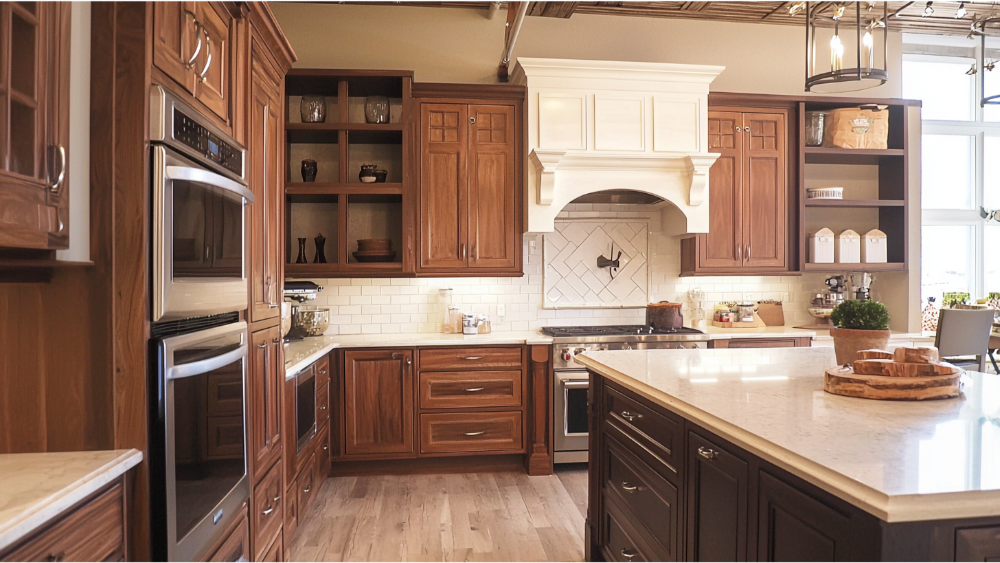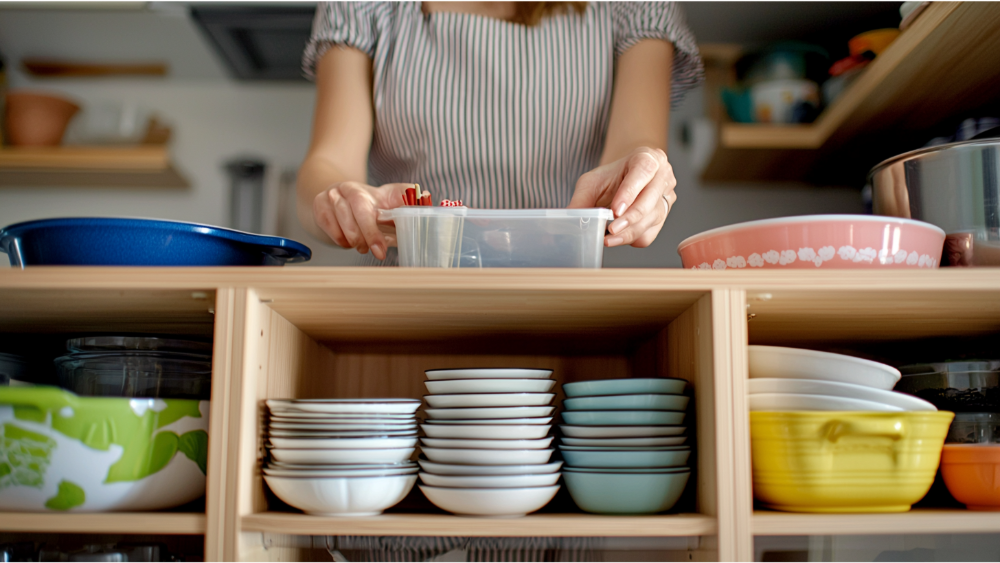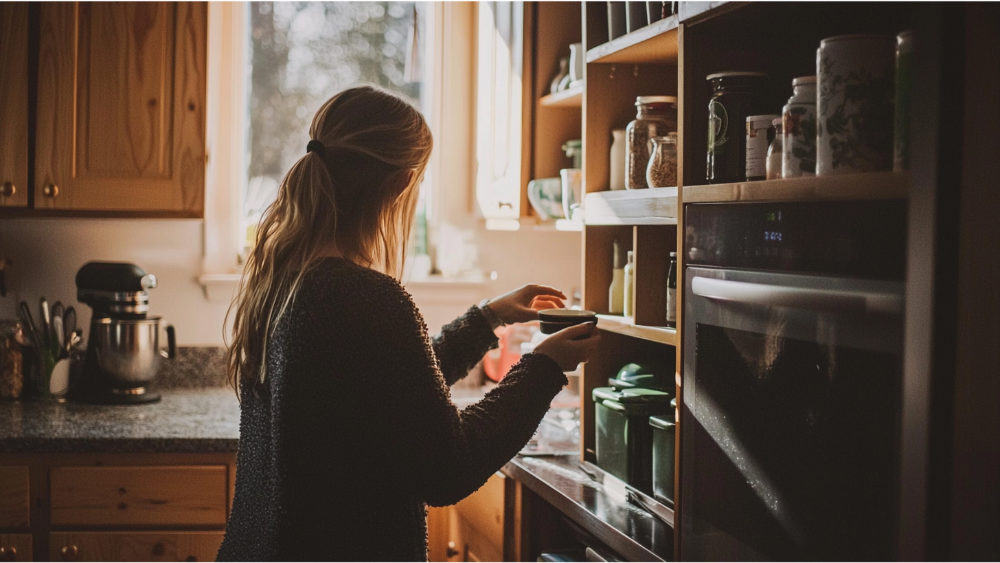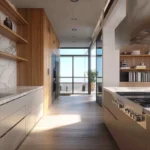
Organizing your kitchen cabinets in 2025 isn’t just about decluttering — it’s about maximizing storage, creating a smooth workflow, and making your kitchen both functional and stylish. Whether you’re working with a small kitchen or a large space, these cabinet organization ideas will help you save time, reduce stress, and keep everything within reach.
Categorizing Items in Each Cabinet

Pantry Staples
Pantry staples such as grains, pasta, and canned goods should be stored together in a designated cabinet space. Utilize storage space efficiently by using stackable food storage containers that allow you to see contents at a glance. Placing frequently used items in upper cabinets keeps them easily accessible while maintaining a neat and organized look.
Baking Supplies
Group baking essentials, including flour, sugar, and baking soda, into one area to make baking projects convenient and enjoyable. Consider placing them in clear food storage containers with labels for easy identification. Storing these items behind cabinet doors can keep kitchen surfaces clutter-free and visually appealing.
Spices and Seasonings

Organize spices and seasonings in a dedicated cabinet space near the stove for quick access during cooking. Magnetic strips or tiered spice racks attached to cabinet doors can save storage space and keep everything visible at a glance. This method ensures that every spice is within reach when you need it.
Cookware and Utensils
Cookware, such as pots, pans, and baking sheets, can be grouped together in lower cabinets or deep drawers. Consider using adjustable dividers to keep items from shifting and maximize your storage space. Storing lids on the insides of cabinet doors can free up even more space, making it easier to find the right pot or pan.
Small Appliances
Store small appliances, like blenders and mixers, in a cabinet space that’s easy to access yet keeps counters clear when not in use. Upper cabinets are ideal if you have limited space elsewhere, but ensure they are sturdy enough to hold the weight. Keeping some of these must-have kitchen appliances behind cabinet doors contributes to a tidy kitchen environment.
Tips for Efficiently Utilizing Space and Organize Kitchen Cabinets

Maximize the Cabinet Door
Consider utilizing the inside of cabinet doors to add extra storage space. Adding adhesive hooks can provide a place to hang measuring spoons, oven mitts, or lightweight kitchen tools, keeping them within easy reach.
This approach not only increases storage options but also enhances overall kitchen organization by keeping items visible and accessible.
Double Your Space with Shelf Rises
Shelf risers are an excellent solution for doubling the available space within your cabinets. These handy tools allow you to stack items vertically, turning wasted air into usable storage. For instance, you can place a riser in your pantry to create separate levels for canned goods and dry ingredients, making them easier to access without having to dig through layers of products. Using shelf risers not only optimizes cabinet space but also enhances overall organization by keeping similar items grouped together, simplifying your kitchen routines.
Designate Spaces with Kitchen Drawers

Designating specific spaces within kitchen drawers can significantly enhance organization and efficiency. Allocate different drawers for utensils, baking tools, and frequently used items to maintain a tidy and orderly space. Drawer organizers can be incredibly useful for separating items like cutlery, ensuring everything has its place and is easy to access. This approach minimizes clutter and streamlines your cooking processes, allowing you to find exactly what you need quickly and effortlessly.
Streamline Cleaning Supplies
Keep your cleaning supplies organized under the sink with bins or pull-out caddies. Group sprays, sponges, and scrubbers by type so they’re easy to grab. Vertical racks or stackable organizers are perfect for maximizing the tight space below the sink, keeping your kitchen both tidy and efficient.
Incorporate Creative Kitchen Cabinets and Drawers Organization Ideas
Incorporating creative kitchen cabinet organization ideas can greatly enhance the efficiency and aesthetics of your kitchen. Consider utilizing pull-out shelving or drawers for easy access to items stored in the back, eliminating the need to dig through cluttered spaces. Deep drawers are particularly useful for storing pots and pans, allowing you to stack them neatly without taking up too much vertical space.
Consider installing drawer dividers to keep utensils and gadgets organized, ensuring that everything has its place. Install lazy Susans in corner cabinets to make use of otherwise lost space, ensuring all items remain visible and within reach. Using clear containers and labels can reduce time spent searching for ingredients, making meal preparation more streamlined and enjoyable.
Maintaining Organization in Kitchen Cabinets and Drawers

Regular Decluttering
Set aside time each month to go through your kitchen cabinets and drawers, removing any items that are broken or not frequently used. Consider whether some items can be repurposed for storage or decor. Regular decluttering helps to prevent overcrowding, making it easier to maintain a tidy and manageable space.
Categorize and Label
Group similar items together, such as all baking utensils in one drawer and dining room serving pieces in another. Use clear containers and labels to keep everything identifiable at a glance. This system reduces the time spent searching for items and ensures that everything returns to its designated spot.
Use Drawer Organizers
Invest in drawer organizers to separate utensils, gadgets, and small kitchen tools. These dividers can also be useful in dining room drawers for organizing cutlery or napkin rings. Organizers maximize space and keep items from getting jumbled together, enhancing both functionality and aesthetics.
Rotate Seasonally
Similar to changing decorations with the seasons, periodically rotate your kitchen items. Move seasonal cooking tools to the front of cabinets when they are needed and store them away when they are not. This keeps your kitchen functional according to the current season’s needs and reduces unnecessary clutter.
Utilize Vertical Space
Just as you might with shelving in the dining room, maximize vertical space in your kitchen cabinets using stackable shelves or risers. This approach allows for more storage above and below existing items, ensuring that every inch of space is utilized efficiently without causing clutter.
Implement a First-In, First-Out System
Use the same strategy often applied in pantries, organizing items so that older products are used first. Keep newly purchased goods at the back and older ones at the front of cabinets. This reduces waste and keeps the flow of items orderly and consistent.
Establish a Weekly Maintenance Routine
Dedicate a short time each week to organizing and cleaning your kitchen cabinets and drawers, similar to the cleaning routine you might have for the dining room. Regular maintenance helps to quickly address any clutter build-up, ensuring your space remains organized and welcoming.
Frequently Asked How to Organize Kitchen Cabinets Questions

How Do I Decide Where to Put Things in My Kitchen?
Deciding where to place items in your kitchen is critical to maintaining an efficient and functional space. Start by assessing your cooking habits and which items you use most frequently. Keep everyday items like pots, pans, and utensils within easy reach, ideally near the stovetop or preparation areas. Consider storing lesser-used gadgets and appliances in higher cabinets or deeper storage spaces.
Group similar items together based on their use; for example, keep baking tools and supplies in one area, and designate another for dishware and cutlery. Take into account the flow of your kitchen work triangle—ensure that the refrigerator, sink, and stove are easily accessible and that necessary items are positioned in proximity to each for a smooth cooking process. Tailor the organization to fit your unique lifestyle and preferences, ensuring that the kitchen layout complements your daily routine.
Where Should I Put Glasses in the Kitchen
When it comes to storing glasses in your kitchen, accessibility and safety should be at the forefront of your organization’s strategy. Ideally, glasses should be placed in a cabinet that is within easy reach of both the dishwasher and dining area to streamline setting the table and unloading clean items. Consider assigning a cabinet near your kitchen sink or a hanging rack for easy access when grabbing a quick drink.
If space allows, organize glasses by type—such as everyday drinking glasses, wine glasses, and specialty glassware—to keep everything tidy and intuitive. For added security, especially if you have children in the household, position delicate glass items on shelves that are out of reach of small hands, but still within easy reach for adults or often-used areas. This ensures that you maintain a clutter-free and efficient kitchen environment where finding the right glass is always a stress-free task.
What Should I Not Store Above the Stove?
Storing items above the stove might seem convenient, but certain things should be avoided in this area due to safety and practicality concerns. It’s advisable not to store oils, spices, or other flammable materials above the stove, as the heat can cause these items to spoil or, in rare cases, lead to a fire hazard. Avoid placing heavier items like large pots or pans in overhead cabinets above the stove, as reaching for them could lead to accidents or injury.
Perishable food items should also be kept away from this spot since the heat can cause them to spoil faster. Electronics or appliances can suffer damage from the humidity and heat generated by stovetop cooking activities, so it’s best to keep these gadgets elsewhere. Maintaining a clear, organized space above the stove enhances kitchen safety and ensures that the area remains functional and efficient.
What is the best way to organize a small kitchen with limited cabinet space?
For small kitchens, focus on vertical storage and multi-use organizers. Use stackable bins, door racks, and shelf risers to double your storage. Pull-out drawers or baskets also make deep cabinets more accessible, preventing items from getting lost in the back.
Conclusion

In 2025, the best way to organize kitchen cabinets is by combining regular decluttering with modern storage solutions like pull-outs, risers, and labeled containers. A well-organized kitchen saves time, reduces stress, and makes cooking more enjoyable. By tailoring your system to your cooking habits and lifestyle, you’ll keep your kitchen functional, clutter-free, and welcoming year-round.
CONTACT US
Our Services
Areas We Serve
Certificate






